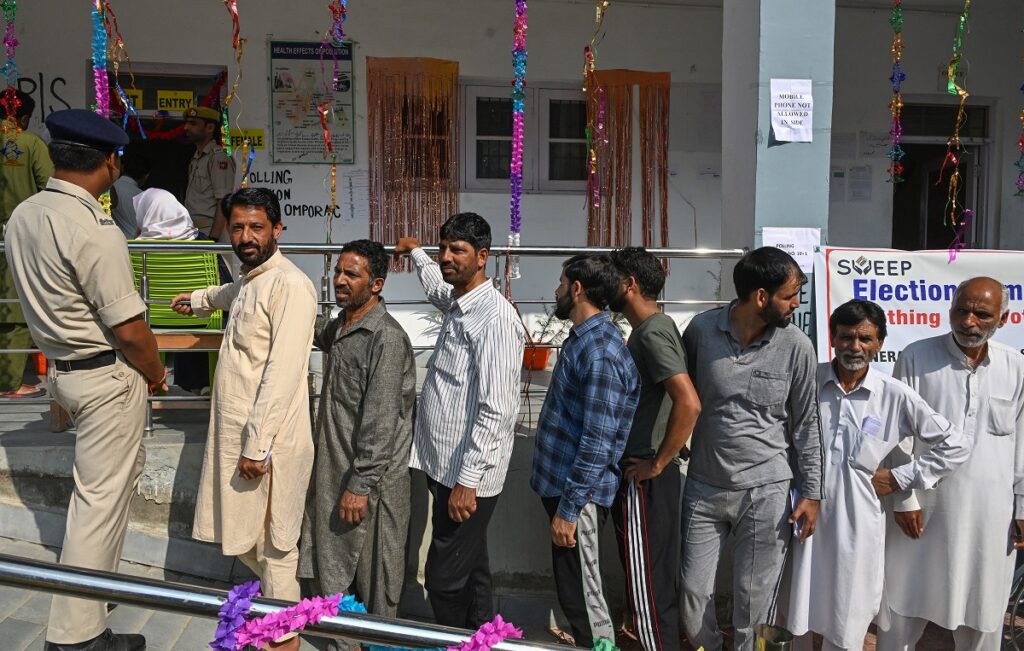
By KO Political Desk
Srinagar- After over 60 percent polling in the first phase, turnout dropped to 57 percent across the six districts in the second phase, with three districts of Kashmir valley – Ganderbal, Budgam and Srinagar – recording just 45.39 percent voting. In contrast, the three districts of Jammu – Reasi, Rajouri and Poonch – saw 73.70 percent.
The tepid participation in the exercise has taken Kashmir observers by surprise who were expecting a pronounced bump in the polling in areas of Srinagar this time around. But this has not happened. Why? It could be anybody’s guess.
The National Conference leader Omar Abdullah said the boycott was the result of New Delhi trying to portray the ongoing polling in Kashmir as a sign of normalcy.
“To be honest, I expected a little more turnout in the second phase as there was no call for boycott. There were no attacks, no attempt to intimidate voters but I reckon to some extent the central government is also responsible,” Omar told reporters during a rally. “They tried to project high turnout as a sign of normalcy. They wanted to show that people are happy after the removal of Article 370. Hence the reaction in Srinagar. People didn’t want to send the wrong message.”
Omar also blamed the central government for bringing a team of diplomats to show them voting in Srinagar, which people didn’t like.
“They wanted to show the diplomats the change in Srinagar,” Omar said. “But people didn’t want to be made use of like this.”
The ongoing Assembly elections witnessed a notable absence: no call for a boycott of the exercise from any quarters, just as there wasn’t one during the recent parliament election. This marks a significant departure from the norm established since the beginning of the separatist struggle in 1989.
However, the absence of a boycott call does not guarantee a high voter turnout in the Valley elections. The reason is that the poll boycott has become both a symbol for standing up for a political cause and a default response among a significant section of people, particularly in urban areas. It is an over three decade old habit and also a commitment which may not go away easily. In the last election, Kashmir Valley polled 50.86 percent votes in the three parliamentary seats — Srinagar, Baramulla, and Anantnag-Rajouri
Since the early nineties, separatists have championed the boycott of elections. Although this trend has seen diminishing returns over the years, the urban areas still witness significant boycotts while the rural areas generally experience higher voter turnout. Many people have still chosen to boycott, but many others have not as the current trend suggests.
Election boycotts have often profoundly impacted the electoral exercise in the Valley. In case of a boycott, even a candidate with little political influence could secure victory. Over the past three decades, there have been numerous instances where candidates with minimal support won elections by narrow margins, subsequently assuming prominent government positions.
The ongoing election is crucial for a city like Srinagar and a few other major towns, which have consistently boycotted polls since 1987 Assembly polls which were widely perceived to have been rigged. The city has been in a limbo ever since.
Although there have been unprecedented changes in the region in the past five years, such as politicians campaigning deep into Srinagar’s interiors, active political participation remains elusive.
This despite the fact that in recent years, people in the Valley have eagerly waited for the restoration of democracy. They have looked forward to the assumption of power by an elected government, giving them both a sense of involvement in decision making and also enabling them to hold the rulers accountable. It is over to the third phase which could be a make or break for parties such as the NC and the BJP.
Follow this link to join our WhatsApp group: Join Now
Be Part of Quality Journalism |
Quality journalism takes a lot of time, money and hard work to produce and despite all the hardships we still do it. Our reporters and editors are working overtime in Kashmir and beyond to cover what you care about, break big stories, and expose injustices that can change lives. Today more people are reading Kashmir Observer than ever, but only a handful are paying while advertising revenues are falling fast. |
| ACT NOW |
| MONTHLY | Rs 100 | |
| YEARLY | Rs 1000 | |
| LIFETIME | Rs 10000 | |













